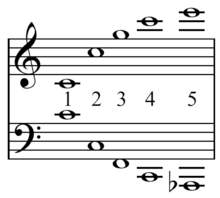Otonality and Utonality

Otonality and utonality are terms introduced by Harry Partch to describe chords whose pitch classes are the harmonics or subharmonics of a given fixed tone (identity), respectively. For example: 1/1, 2/1, 3/1,... or 1/1, 1/2, 1/3,....
Definition
An otonality is a collection of pitches which can be expressed in ratios, expressing their relationship to the fixed tone, that have equal denominators. For example, 1/1, 5/4, and 3/2 (just major chord) form an otonality because they can be written as 4/4, 5/4, 6/4. Every otonality is therefore composed of members of a harmonic series. Similarly, the ratios of a utonality share the same numerator. 7/4, 7/5, 7/6, and 1/1 (7/7) form a utonality. Every utonality is therefore composed of members of a subharmonic series.
An otonality corresponds to an arithmetic series of frequencies, or lengths of a vibrating string. Brass instruments naturally produce otonalities, and indeed otonalities are inherent in the harmonics of a single fundamental tone. Tuvan Khoomei singers produce otonalities with their vocal tracts.
Utonality is the opposite, corresponding to a subharmonic series of frequencies, or an arithmetic series of wavelengths (the inverse of frequency). The arithmetical proportion "may be considered as a demonstration of utonality ('minor tonality')."[1]
Relationship to standard Western music theory
Partch said that his 1931 coinage of "otonality" and "utonality" was, "hastened," by having read Henry Cowell's discussion of undertones in New Musical Resources (1930).[2]
The 5-limit otonality is simply a just major chord, and the 5-limit utonality is a just minor chord. Thus otonality and utonality can be viewed as extensions of major and minor tonality respectively. However, whereas standard music theory views a minor chord as being built up from the root with a minor third and a perfect fifth, an utonality is viewed as descending from what's normally considered the "fifth" of the chord, so the correspondence is not perfect. This corresponds with the dualistic theory of Hugo Riemann:

In the era of meantone temperament, augmented sixth chords of the kind known as the German sixth (or the English sixth, depending on how it resolves) were close in tuning and sound to the 7-limit otonality, called the tetrad. This chord might be, for example, A♭-C-E♭-G![]() ♭[F♯]
♭[F♯] ![]() Play . Standing alone, it has something of the sound of a dominant seventh, but considerably less dissonant. It has also been suggested that the Tristan chord, for example, F-B-D♯-G♯ can be considered a utonality, or 7-limit utonal tetrad, which it closely approximates if the tuning is meantone, though presumably less well in the tuning of a Wagnerian orchestra.
Play . Standing alone, it has something of the sound of a dominant seventh, but considerably less dissonant. It has also been suggested that the Tristan chord, for example, F-B-D♯-G♯ can be considered a utonality, or 7-limit utonal tetrad, which it closely approximates if the tuning is meantone, though presumably less well in the tuning of a Wagnerian orchestra.
Consonance
Though Partch presents otonality and utonality as being equal and symmetric concepts, when played on most physical instruments an otonality sounds much more consonant than a similar utonality, due to the presence of the missing fundamental phenomenon. In an otonality, all of the notes are elements of the same harmonic series, so they tend to partially activate the presence of a "virtual" fundamental as though they were harmonics of a single complex pitch. Utonal chords, while containing the same dyads and roughness as otonal chords, do not tend to activate this phenomenon as strongly.
See also
Sources
- ↑ Partch, Harry. Genesis of a Music, p.69. 2nd ed. Da Capo Press, 1974. ISBN 0-306-80106-X.
- ↑ Gilmore, Bob (1998). Harry Partch: A Biography, p.68. ISBN 9780300065213.
External links
- Otonality and ADO system at 96-EDO
- Utonality and EDL system at 96-EDO


